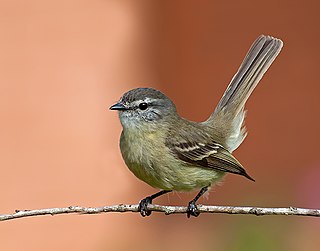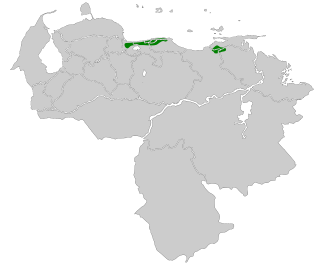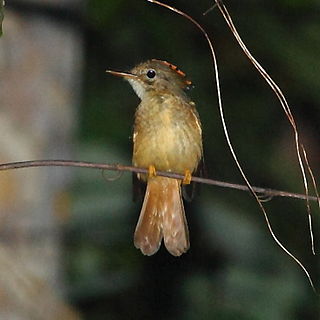
The red-rumped woodpecker is a species of bird in the subfamily Picinae of the woodpecker family Picidae. It is found from Costa Rica south to Peru and east to Brazil, Guyana, and Trinidad and Tobago.

The dusky-capped flycatcher is a passerine bird in the tyrant flycatcher family. It breeds in forest and other woodland from southern Arizona, as well as the Chisos Mountains, Texas, south to northern Argentina and on Trinidad. It is resident in most of its range, but American breeders retreat to Mexico in winter.

The yellow tyrannulet is a very small passerine bird in the tyrant flycatcher family. It breeds from Nicaragua south to northeastern Argentina and southeastern Brazil. It is the only member of the genus Capsiempis, but its taxonomy is uncertain, and it has been allocated to at least three other genera in the past.

The mountain elaenia is a small passerine bird in the tyrant flycatcher family. It breeds in highlands from Guatemala to Colombia and western Venezuela. The scientific name celebrates the German physician and naturalist, Alexander von Frantzius.

The Tachira antpitta is a Critically Endangered bird species in the family Grallariidae. It is endemic to Venezuela.

The great dusky swift is a species of bird in subfamily Cypseloidinae of the swift family Apodidae. It is found in Argentina, Brazil, Paraguay, and possibly Bolivia.

The planalto tyrannulet is a species of bird in subfamily Elaeniinae of family Tyrannidae, the tyrant flycatchers. It is found in Argentina, Bolivia, Brazil, and Paraguay.

Reiser's tyrannulet is a species of bird in subfamily Elaeniinae of family Tyrannidae, the tyrant flycatchers. It is found in Brazil and Paraguay.

Sclater's tyrannulet is a species of bird in subfamily Elaeniinae of family Tyrannidae, the tyrant flycatchers. It is found in Argentina, Bolivia, and Peru.

The greenish tyrannulet is a species of bird in subfamily Elaeniinae of family Tyrannidae, the tyrant flycatchers. It is found in Argentina, Brazil, Paraguay, and Uruguay.

The white-throated barbtail is an Endangered species of bird in the Furnariinae subfamily of the ovenbird family Furnariidae. It is endemic to Venezuela.

The grey-throated leaftosser is a Near Threatened species of bird in the subfamily Sclerurinae, the leaftossers and miners, of the ovenbird family Furnariidae. It is found in Bolivia, Brazil, Colombia, Costa Rica, Ecuador, Panama, Peru, Trinidad and Tobago, and Venezuela.

The Caracas tapaculo is a species of bird in the family Rhinocryptidae. It is endemic to Venezuela.

The black-throated spinetail is a species of bird in the Furnariinae subfamily of the ovenbird family Furnariidae. It is endemic to Venezuela.

McConnell's spinetail is a species of bird in the Furnariinae subfamily of the ovenbird family Furnariidae. It is found in Brazil, French Guiana, Guyana, Suriname, and Venezuela.

The pale-headed jacamar is a species of bird in the family Galbulidae. It is found in Colombia and Venezuela.

The tropical royal flycatcher is a passerine bird that the International Ornithological Committee (IOC) places in the family Tityridae. It is found in Mexico, south through most of Central America, and in every mainland South American country except Argentina, Chile, Paraguay, and Uruguay.

The Yungas tyrannulet is a Vulnerable species of bird in subfamily Elaeniinae of family Tyrannidae, the tyrant flycatchers. It is found in Bolivia and Peru.

The white-fronted tyrannulet is a species of bird in the family Tyrannidae. It is found in Colombia, Costa Rica, Ecuador, Panama, Peru, and Venezuela. Its natural habitats are subtropical or tropical moist lowland forest and subtropical or tropical moist montane forest.

The Venezuelan parakeet or Emma's conure is a species of bird in subfamily Arinae of the family Psittacidae, the African and New World parrots. It is endemic to Venezuela.





















